|
  Dr Elizabeth Minchinton Dr Elizabeth Minchinton
Department of Primary Industries Victoria
Private Bag 15,
Ferntree Gully Delivery Centre,
VIC, 3156
Tel: 03 9210 9222
Fax: 03 9800 3521
|
|
 Expertise: Expertise:
- White Blister of brassicas
- Downy and powdery mildews
- Foliage diseases, predictive models and IPM disease control
- Fungal and bacterial of diseases of tomatoes
- Diseases of bunching vegetables, brassicas, celery, parsley, parsnip and spring onions
|
|
Elizabeth Minchinton 2006 Vegetable Researcher of the Year
The AUSVEG 2006 Vegetable Researcher of the Year Award was awarded to Dr Elizabeth Minchinton of the Victorian Department of Primary Industries for her ongoing contributions to vegetable research in the field of plant pathology.
|
|
VG
08026 IPM Strategies for Pythium root rots in Apiaceae crops
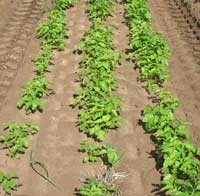 This national project will determine the role of Pythium fungi in root rots and cankers of Parsley, Coriander and Parsnip. This national project will determine the role of Pythium fungi in root rots and cankers of Parsley, Coriander and Parsnip.
The project will identify factors contributing to disease and develop integrated disease management strategies.?
Pythium are parasitic root fungi, common in vegetable crops and the damage they cause often goes unnoticed.?
Damage can affect small lateral roots, reducing water and nutrient uptake and limiting crop growth.
In extreme cases Pythium causes “damping-off” disease of seedlings and cavity spot on carrots.
|
|
 VG VG
07070 Benchmarking disease predictive models
White blister disease on brassicas:
-
Irrigation: trials indicate that incidence of Whie Blister could be halved in susceptible broccoli varieties by irrigating at 6am rather than 8pm.
- Prediction: Weather based models reduced the number of sprays by up to 85% but did not control White Blister as well as the weekly copper sprays ?
Identifying white blister resistant varieties:? Two broccoli varieties; ‘Booster’ and ‘Tyson’, did not show symptoms of White Blister disease in a trial of six broccoli and two cauliflower varieties.
Lettuce downy mildew:
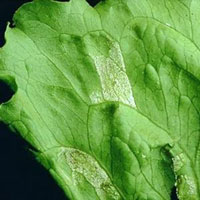 Predictive model – The models for downy mildew on lettuce are being compared with the observed incidence of the disease in the field. Predictive model – The models for downy mildew on lettuce are being compared with the observed incidence of the disease in the field.
Alternative approaches to leaf wetness sensors:
Laboratory trials at University of Queensland have identified a ‘Fuzzy Logic’ model that better simulates actual leaf wetness.
Plant nutrition: SARDI are studying of the effects of nitrogen fertiliser on the incidence of downy mildew in lettuce.
|
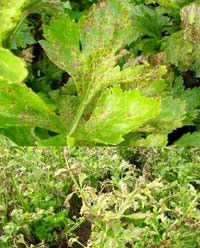 VG 06047 VG 06047
Predicting Septoria late blight in Celery
- Weather-based disease forecasting was able to control of Septoria late blight in Celery.
- The system was able to nearly halve the cost of controlling septoria in celery crops.
- Greatest savings could be made in the early stages of crop production, before canopy closure.
- VG 06047 final report – extract
|
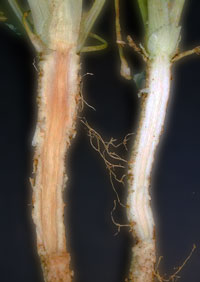 VG 06046 Management of root-rot diseases in Parsley VG 06046 Management of root-rot diseases in Parsley
- 12 months extension of VG 04025 to refine the management and control of Parsley root rot.
- Fungicides reduced the incidence of the disease up to 97%
- Controls for parsley root rot include fungicides and tolerant varieties.
- VG 06046 final report – extract
|
|
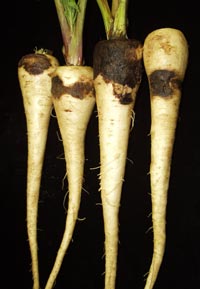 VG 05045 Management of Parsnip Canker VG 05045 Management of Parsnip Canker
- Parsnip growers have reported severe losses
of up to 80% from parsnip canker.
- Growers now have information on the cause, extent and possible predisposing factors for parsnip canker.
- VG 05045 final report – extract
|
|
 VG 04025 Scoping study of root-rot diseases in parsley VG 04025 Scoping study of root-rot diseases in parsley
Parsley Disease Handbook
This “Guide to Common Diseases of Parsley” (2006, 46 pages), describes 18 parsley diseases and disorders common across Australia.
Symptoms are clearly shown in over 30 colour photos and practical control measures are suggested.
The diseases and disorders listed in this book often occur on parsley in Australia.
Many carrot and celery diseases and disorders also affect parsley and several can occur on plants at the same time.
|
 VG 04016 Scoping study VG 04016 Scoping study
to manage Septoria late blight in celery
Late blight is the major leaf disease of celery.
It first appears as brown spots on older leaves and can quickly spread through the crop.
The disease is currently controlled with routine weekly sprays of protective fungicide.
- A weather-based disease forecasting system was found effective at reducing fungicide applications
and control late blight in celery crops until canopy closure, but not beyond.
- The trials have shown winter celery crops can be produced practically free from late blight saving over $400/ha in fungicide costs.
- Celery Poster
- VG 04016 final report – extract
|
 VG 04013 Management VG 04013 Management
of white blister (rust) in crucifer crops
White blister, affects brassicas such as broccoli and devastated Victorian crops in 2001-2002.
The initial source of disease not identified and there was no evidence that seed was the source.
A number of fungicides that control the disease were yet to be registered for use.
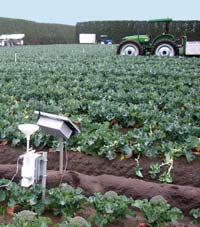
|
|
 VG 02118 Control of rust on crucifers VG 02118 Control of rust on crucifers
VG 01045 Control of bunching vegetable diseases
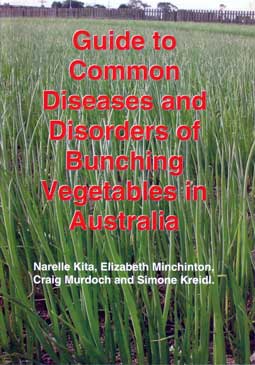 This “Guide to Common Diseases and Disorders of Bunching Vegetables in Australia”(2003, 58 pages) was produced by the R&D levy funded project VG010045. This “Guide to Common Diseases and Disorders of Bunching Vegetables in Australia”(2003, 58 pages) was produced by the R&D levy funded project VG010045.
The diseases and disorders listed in this book often occur on bunching vegetables in Australia and several can occur on plants at the same time.
Crops covered include:
- Bok Choy / Pak Choy
- Beetroot
- Coriander
- Dutch carrots
- Parsley
- Radish
- Spinach
- Spring onions
NY 97011 Integrated control of downy mildew on nursery seedlings
NY 406 Downy mildew on nursery plants
Earlier Work – DPI Victoria
Control of powdery mildew (Oidium lycopersici) in processing tomatoes.
Integrated Pest Management for fungal diseases of processing tomatoes.
Control of downy mildew in Brassica seedlings
Contingency plans for fire blight on pears in the Goulburn Valley
and other pome fruit districts.
Control of black leg, black scurf and other postharvest storage rots
of seed potatoes.
Control of black rot (Xanthomonas campestris) in Brassica seeds.
Control of a bacterial leaf spot and stem rot disease of carnations.
Epidemiology and control of bacterial head rot in Broccoli.
|